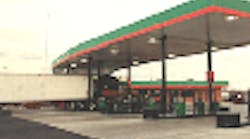With all the major manufacturers now settled on their engine solutions for 2010 Environmental Protection Agency (EPA) compliance, the focus is shifting to the infrastructure for diesel exhaust fluid (DEF) distribution.
Asked if the distribution network will be in place by 2010, Dave Uschwald, director of SCR infrastructure development for Detroit Diesel Corporation, says yes. Detroit Diesel has joined other industry leaders in the North American SCR Stakeholders Group, an organization founded a few years ago primarily by the auto industry, and now promoting DEF distribution and education for the trucking industry.
“I’m quite certain all the major truck stops will be offering fueling at the filling tanks alongside diesel,” Uschwald said. DEF, which is approximately 66% water and 34% urea, will be available in a multiple of sizes, from 2 ½ gal. “emergency fills,” to bulk tanks of 275 gals. or more. According to Uschwald, the emergency fills, which all the truck stop providers he’s spoken with have said they will carry, can provide up to 650 mi. of additional travel for a driver who may be running low on DEF. Typically, a 23-gal. on-board tank will carry each truck about 6,500 mi., making it easy in most cases for trucks to remain supplied with the critical fluid.
“There’s also going to be a locator available from the Dept. of Energy that will show you where you can get it,” he said. The locations will likely be available online as well as in booklets for drivers. Also, Uschwald said it’s probable that drivers will be in the habit of storing an emergency fill container onboard just in case.
Since urea is currently used in other applications, Uschwald said he doesn’t foresee any problems with the distribution. Many companies will likely purchase urea in bulk and store it at on-site facilities.
The Stakeholders Group has started to shift its focus from ensuring distribution of urea to education. David Siler, director of marketing for Detroit Diesel, said the heavy-duty truck industry got involved with the group this year when it became apparent that some aspects unique to trucking, like bulk distribution at truck stops, were not being addressed.
“When we launched our Daimler SCR initiatives … we thought there were four things we had to get across to our customers,” he said, pointing out that proving SCR technology was better economically, cleaner, convenient and reliable was the focus. “It’s our job to prove the infrastructure is in place and that’s what the group is doing.”
A subset of the group focused on the Class 8 truck industry quickly formed. The group held a workshop a few weeks ago hosted by Daimler Trucks North America, Detroit Diesel, Mack Trucks, Paccar and Volvo Trucks North America. In all, the Stakeholders Group includes about 200 public and private organizations, including the U.S. Dept. of Energy, EPA, automotive and heavy-duty engine and truck manufacturers, trade associations, fuel retailers and truck stop trade associations among others.
Siler pointed out that unlike previous EPA-mandated changes that usually preceded a drop in fuel economy, the switch to SCR provided “a real big break from recent EPA mandates. Also, there is a real change in our customers” that now embrace green technologies. Because of that, a greater emphasis is being placed on ensuring everything is in place and, in particular, customers, legislators and other industry partners are educated in the benefits of SCR technology.
With so many industries and interests involved, Siler found two surprises when Detroit Diesel first became involved. “When we launched our SCR brand of technology, we didn’t realize [heavy-duty engine makers] were going to have to bear the weight of the education on the heavy-duty side …but then we were pleasantly surprised by how quickly it came together,” he said.
View more Fleet Owner management news and other commercial trucking-related articles.



